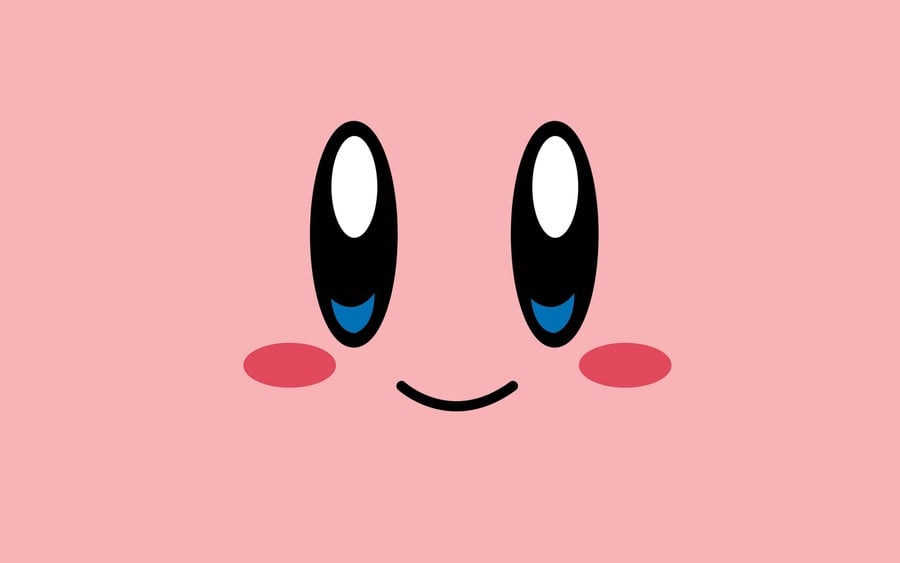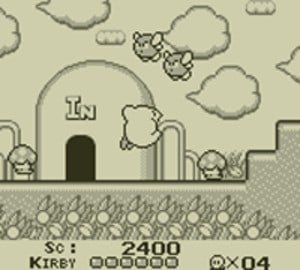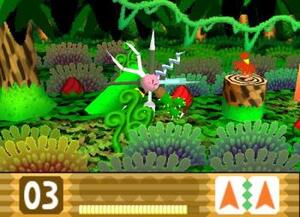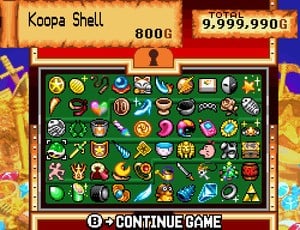
It’s been 22 years since Kirby made his debut in the 1992 Game Boy confection Kirby’s Dream Land. In that time, players have seen the lovable pink puffball grow to become one of Nintendo’s biggest stars, scoring it big in hit after hit on both consoles and portables. Those not quite in the know about Nintendo’s irresistible charm may find themselves confused by the appeal of a pink blob running his way through colourful environments named after food — but what’s deceptive about Kirby is that sophisticated game design follows him wherever he goes. Both Satoru Iwata and Masahiro Sakurai, who helped bring Kirby to the screen back in their days at HAL Laboratory, were gamers before they were game designers, and this is definitely reflected in the final product.

Platformers have been seen as a dying breed in recent years; with first-person shooters on the rise and an increasing demand for mature "hardcore" titles, it seems hard for a cuddly series like Kirby to hold its own in today’s market. But as Nintendo of America President Reggie Fils-Aime once said of players, “They know Kirby’s got game.” Indeed we do: anyone who’s grown up with Kirby games will be sure to gush about their favourite experiences through the years exploring Dream Land. What makes all that possible is the fantastic level design, a feature consistent with just about every game in the series. Just like many games featuring Masahiro Sakurai’s direct involvement, the Kirby titles invite players to wander off the beaten path in search of treasures and secrets, rewarding them for their knowledge of the character's abilities and the worlds he explores.
The main gimmick of Kirby (beginning with the NES classic Kirby’s Adventure) is, of course, the ability for our hero to inhale the enemies around him and swallow them, thereby copying their powers for himself. Because there are so many copy abilities located within any individual level, knowing which ability to steal and where to use it is essential to uncovering all the secrets a Kirby game has to offer. Need to pound a stake in to send the barrier around an item tumbling away? You’re looking for the Hammer ability. Need to light a fuse to send Kirby flying from a cannon? You’re looking for the Fire — or Fireball — abilities. Kirby is certainly not the first platformer to utilize power-ups in this way, but the level design accommodates a player's instinct to make use of abilities in unconventional ways that might net them a reward. This has been taken to new heights over the long history of the pink puff, with games like Kirby 64: The Crystal Shards and Kirby: Squeak Squad even allowing players to combine abilities — an invitation for player creativity that really expands the potential for experimenting.
Subscribe to Nintendo Life on YouTube841k

Of course, looking for treasures and secrets is a wonderful goal all its own — but one of the interesting things about Kirby is that his titles have been some of the first to offer visual encouragement for not just completing a game, but utterly conquering it. Kirby's Adventure not only brought the famous copy abilities to the forefront, but also was the first in the series to dangle the 100% carrot in front of players' faces. In this particular iteration, players could unlock an Extra Game (essentially a hard mode) if they sought out each of the secret switches hidden within certain levels. This extra incentive was one many players at the time undertook as a personal challenge, but to have the game itself present a reward for finding everything it has to offer was an absolute delight. Many of the following games have also provided such an incentive, hitting a peak with fan-favourite Kirby Super Star's The Great Cave Offensive. This Metroidvania-style treasure hunt is one of the most popular Kirby adventures to date, even as it remains just one part of the much larger overall Super Star title. More than any other, this Kirby makes the most of players' desire to explore and their knowledge of the character's abilities to find every one of the 60 treasures hidden within the titular cave as fast as possible.

What makes Kirby's adventures so consistently enjoyable is the constant commitment to satisfying the basic instincts of gamers. The talented team behind the pink puff seem to pride themselves on knowing what most people want from a video game — tons of content, new ways to challenge one's skill, and design that rewards knowledge of the mechanics. When you play a Kirby game, you need not fear a lack of pay-off — what the games may lack in conventional "hardcore" appeal they more than make up for with gratifying game design that takes us, as players, seriously. Ultimately, what more can we ask for from our hobby? Sure, Kirby may look like a "kiddy" game, and perhaps the initial challenge level isn't as high as some others we enjoy, but beyond the adorable exterior lies a game designed by players, for players. Sakurai-san must be so proud.





Comments 34
Kirby games are definately rewarding. It's always a challenge when you need to carry a copy ability throughout an entire level to get to a secret with no enemies in the level being able to restore the ability. But when you succeed the feeling is amazing.
I enjoy Kirby, but it always bothers me when the series is referred to as a platformer. If you can fly and don't have to worry about precise jumping to avoid falling, then by definition it's not a platformer. It's an action game, plain and simple.
Unless you wanna say that it is a platformer with built-in Game Genie code automatically turned on to let you cheat death by floating...
only month of Kirby!?!?!
it needs a decade(or at least a year)
@sketchturner I dunno, who cares what it is? It's Kirby.
@PLATINUM7 Thats no challenge it is the exception rather than the rule that doesn't happen. Carrying a key through the whole level would be a whole different thing but they never seem to go for that.
"Platformers have been seen as a dying breed in recent years"
What? Well that's news to me...
@Geonjaha Yea Platformers could be extinct it is a rumor because of the price 50-60 dollars. When you have smartphones rising in popularity every day it has to take a place of something. Another example look at the Ouya, and Amazon Fire their games are the prices of smartphone games. I know a lot of parents that would rather shell out a few dollars than 50-60 when buying for their kids.
@biglittlejake - With "Triple A" releases I'd agree, but there are so many good indie Platformers out there and coming out all the time. I don't think you can really say they're a dying breed considering how many other game genres have disappeared.
Okay, look. I love Kirby Super Star, and I'm proud to have its remake in my DS card bag. But don't put "good game design" and "The Great Cave Offensive" in the same sentence... swap it with Return Of Meta Knight and we're in business!
Funny, I really don't like The Great Cave Offensive and Kirby 64. They are very boring, specially the later.
I'm gonna be totally honest:
I don't get Kirby games.
They're platformers without the need for timing, reflexes, and stripped of almost all challenge?
I suppose the target audience is small children, but I don't think they're even particularly well designed. Don't get me wrong...the gaining enemy ability thing is pretty cool, but Megaman did that first and much better.
Sorry for being "that guy", but the ability seen in the Kirby 64 screenshot is actually made by combining two needles (the orange ability); combining two cutters gives you a giant boomerang.
@Action51
The challenge in Kirby games is provided by the bosses, which, in stark contrast to the exploration (barring early ones), are downright brutal. Add that to the boss rush that nearly every game has, and there you go.
You're missing out anyway. And for the "better variant" of power copying, check out the "Milky Way Wishes" part of Kirby Super Star, in which powers must be collected but, once you get 'em, they stick.
Kirby games are just fun, they are designed to be fun.
@Action51
I wouldn't say they're devoid of challenge. Just platforming through is a tad easy, but the rest of the challenge comes from a puzzle aspect. Finding the right ability to reach certain areas or get to an item- it's that classic Nintendo "use your brain" gameplay.
@Geonjaha
Maybe not for indie games (every genre is represented in indies) but for full blown retail releases- yes, classic 2D platformers are a dying breed. During the N64 and Gamecube eras we saw virtually zero 2D platformers. The 3D pendulum was swinging the other way- unfortunately it swung a little too far, to the extent that 2D platformers were all but extinct.
It wasn't until New Super Mario Bros that the 10 year moratorium on 2D platformers was lifted. Then there was Donkey Kong Country Returns.Oh, and Rayman Origins. And, that's pretty much it for the entire Wii/DS era. Unless you count Kirby- but Kirby doesn't fit the definition of a platformer- yes it's 2D, but it's not really a platform game. Now it's the Wii U era, and I'm pretty sure that once again, NSMBU, DKC Tropical Freeze and Rayman Legends will be the only 2D platformers we'll see this entire generation.
Those three franchises are the only 2D platformers left nowadays as far as full retail releases go. It's sad, really.
@ZettaToad I was about the post the same thing.
@ZettaToad Whoops! Good eye! That error was made because I used a pre-release screenshot, and all of those had the Needle and Cutter icons swapped! I'll see if I can get that fixed.
I remember in one particular instance in the Great Cave Offensive where you have to take your fire ability but then turn it into a helper in order to burn something underwater. It took me quite a bit to figure that out.
Super Star Ultra was a game I 105% (or 110?) it offered so much content on the DS and remains one of my favorite DS games. Kirby games are amazing and pretty easy platformers (imo at least) but I guess that's Nintendo's magic. Every platformer they have always feels so unique from each other.
@JaxonH - I disagree. There are plenty of genres that are pretty much extinct now, besides maybe a few indie games. Platformers are very common in the indie scene, and overall there are lots of Platformers released.
Great, I love kirby
@Geonjaha
Again, I was referring to full retail releases. Which after all, is the reason we buy consoles.
Swell article.
I love Kirby so much. Some of my earliest gaming memories are of me playing the first game on my Game Boy. He's kinda been with me for my whole life. He's a few months older than me. :B
I've always found Kirby games to be supremely satisfying. I'm so hyped for Triple Deluxe.
Can you spot Kirby from this complete NA N64 collection?
http://kotaku.com/an-entire-nintendo-console-generation-in-one-image-1568067726/all
@JaxonH There is loads more 2D Platformers on the Wii -
Warioland : The Shake Dimension is probably the best other than DKCR but there is also - A Boy and His Blob / Klonoa / Epic Yarn / Rayman Origins (Which is garbage) / Nights: Journey of Dreams / Okami
Gamecube had Billy Hatcher and the Giant Egg which is great also.
Thing about platformers is the most important thing is the level design and the controls nothing else matters.
There is still loads of retail platformers.
What I want from a console is diversity something good across every genre that I liked which is most of them. (Don't like console FPS or RTS on a console or the stereotypical Metroidvania or slow puzzle platformers).
Doesn't bother me whether something is retail or not just has to be exclusive and the system as a whole has to be diverse. (i.e at least something in most of the genres I like).
Take the Gamecube
I like :
Ikaruga
Alien Hominid
F-Zero GX
Gauntlet - Dark Legacy
Skies of Arcadia Legends
Mario Power Tennis
Megaman X Collection
Paper Mario - Thousand Year Door
Sega Soccer Slam
Warioware - Mega Party Game
Warioworld
Viewtiful Joe 2
Billy Hatcher and The Giant Egg
Simpsons - Hit and Run
Crazy Taxi
Super Monkeyball 2
Sonic Adventure 2 Battle
Super Smash Bros Melee
Capcom vs SNK 2
Star Soldier
Star Wars : Rogue Squadron 2
I've never been able to get into Kirby. The controls feel off, Kirby's characteristic floatiness just doesn't jive like Mario's solid feel, and the light-hearted experimentation of the games just doesn't seem to go far enough. But as one of Nintendo's most prolific series, Kirby games do have their fans.
@Mahe Yeah but even though it feels jarring it is not actually broken like many other games that are described as having floaty controls.
@Geonjaha I agree there are lots of genres that are pretty much extinct for Retail games 2D Platfomers never was one of those. (During the Gamecube era the PS2 had at least about 20 that were somewhat reasonable).
@unrandomsam
A 2D platformer is not just defined as side scrolling. It is defined as also having platforms you must jump to separated by pits and/or obstacles. WarioLand Shake it was more of a non-traditional hybrid, but ok. I already mentioned Rayman Origins, and again, Epic Yarn not so much a platformer. Klonoa, yes, I forgot that one and I own it. Okami is not a 2D platformer, heck it's not even a 3D platformer.
Point is, out of what, 3,000 games on the Wii, I can count the 2D platformers on my left hand. There's 3 on Wii U, and it's probably gonna stay at 3 for the rest of this gen. There's ZERO on PS4 and X1. All 3 consoles are lacking in certain genres. I will give Nintendo credit where it's due though- at least they have a couple on their systems, which is better than none at all. So yeah, I'm happy about Wii and Wii U having at least some, as opposed to the drought we faced during the 5th and 6th generations.
I buy indies and digital games too, but there is a difference in quality between a game that goes to retail at $59.99 and a $10-15 digital release. And while I love buying both kinds of games, most gamers (myself included) want to see a good number of games of each genre as high quality, retail releases. I don't just want to play indie platformers or VC/PSN versions of SRPGs. I know these are more niche markets but still- at least the DS had Advance Wars and Final Fantasy Tactics along with Fire Emblem. I'll take the digital releases as well though.
thank you jowi. I love kirby, like almost as much as i do mario.
Never played a Kirby game in my life but picking the new one up in May for sure
Kirby's succeeded maybe because in the west, Nintendo has marketed him as hardcore.
Can't forget the original commercial. Kirby wins! Fatality!
https://www.youtube.com/watch?v=paP177p1RVQ
Although he was kind of a jerk in the Japanese commercial, too. Poor little kid.
https://www.youtube.com/watch?v=K_k1HvWcTDc
Kirby didn't originally have the copy ability did he? Kirby's Dreamland on GB had no copy ability, right?
Still loving kirby
Show Comments
Leave A Comment
Hold on there, you need to login to post a comment...